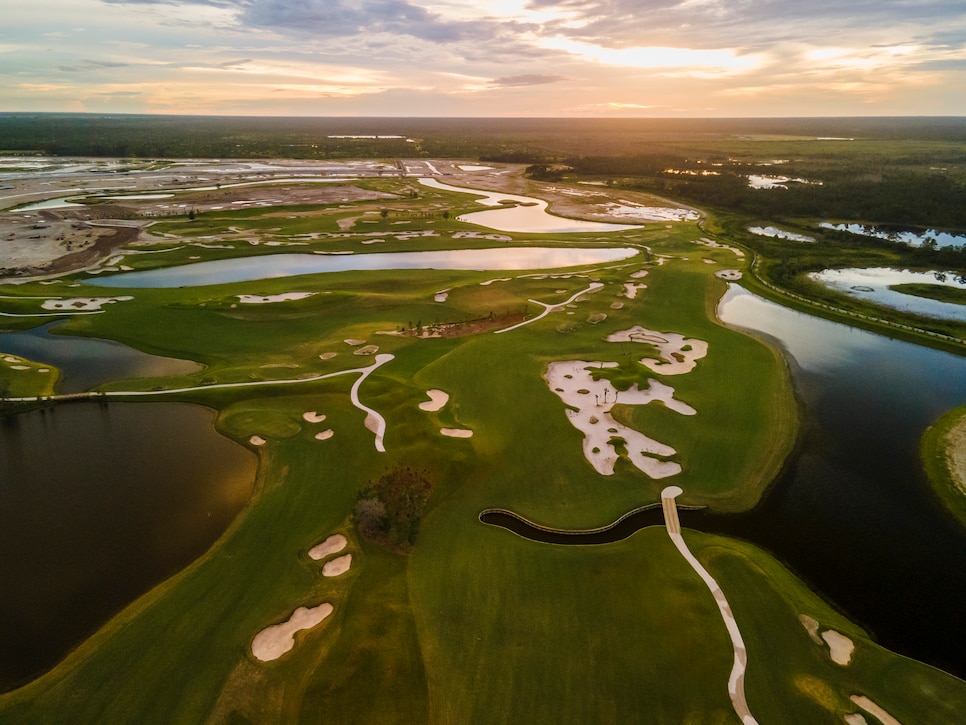Ken Bakst, the founder and developer of Friar’s Head on Long Island, crouches into the driver’s seat of a two-man Gator utility vehicle and cranks the engine. We’re off to explore what will become The Ranch, his soon-to-be 36-hole golf club in Martin County, Florida. We drive for half a mile across barren pastureland and through a series of steel gates that prevent the wanderlust of the roughly 800 head of cattle that call the property home. Eventually we come to a section of land that looks mostly like what we’ve passed: flat, grassy and intersected with drainage ditches. A few pockets of trees break the horizon, but the only other elevations are dozens of seven-foot-high white stakes that represent the tees, fairways and greens of what will become the East and West courses.
Little here suggests the makings of a national-level golf club: no heaving sand dunes, no sunset marsh vistas, no forests of elevated tees and cascading creeks. It’s difficult to envision an architecturally compelling design existing on this site, but Bakst has been through this before. Large portions of Friar’s Head, now ranked 15th on America’s 100 Greatest Golf Courses, were dead flat and had to be transformed into a riveting tapestry of sand, bumps, fescues and frolicking turf, much of the work done by Dave Axland and Rod Whitman, who helped construct the course for architects Bill Coore and Ben Crenshaw in the early 2000s. Axland, Whitman and partner Keith Cutten will build The Ranch. As Bakst sees it, this property has the potential to achieve something greater than its countenance suggests.
Some of the most esteemed players in investment, real estate and golf development—Bakst at The Ranch; Michael Pascucci at The Apogee Club with partner Stephen Ross; Discovery Land Company with Atlantic Fields; investment broker Chris Shumway’s Rolling Sands; and Dominik Senn’s Panther National (15 miles south in Palm Beach Gardens)—are sensing something similar, namely an opportunity to capitalize on the surging demand for private golf in this section of Florida. Across a 10-mile stretch of Martin County, west of the sleepy beach town of Hobe Sound and just north of Jupiter, these investors are building or preparing to build eight private upscale courses at five properties. Another club, McArthur, has added a second course that will open this fall. The plans total 162 new golf holes, not counting several short par-3 and regulation-length practice courses.
What exactly is happening in Martin County, and to a lesser extent adjacent Palm Beach County, that’s so attractive to golf’s highest rollers and prognosticators? For 15 years, almost all new course construction has been driven not by need or location but rather by the discovery of gorgeous golf sites like Streamsong and Sand Valley. A lot of squinting is required to picture a similar level of destination-worthy golf in Hobe Sound. As one architect familiar with the properties puts it, “These people are investing tens of millions of dollars, and none of the sites are any good.”

OPENING IN 2023 Panther National is built on one of Palm Beach County’s last pieces of usable golf land. Photograph by Jensen Larson
Imagination, engineering and money will be required to transcend the limitations of these flat parcels that are largely indistinguishable from the terrain on which hundreds of other south Florida courses have been built. Tabbed with making that happen are some of the biggest architects in the profession. In addition to Whitman, Axland and Cutten are Bill Coore and Ben Crenshaw; Tom Doak; Gil Hanse and Jim Wagner; Tom Fazio; Tommy Fazio and Mike Davis; Kyle Phillips; and Nicklaus Design.
It amounts to what may be the biggest architectural bake-off in the history of the profession, with the generation’s top designers working virtually simultaneously within miles of each other, none with a clear topographical advantage or any relative budget constraint. Similar architectural flurries happened in locales like Westchester County (New York), Los Angeles and Chicago in the 1910s and 1920s, but those were slower and the result of population growth and city expansion. It’s also different from contemporary epicenters like Bandon Dunes or Kiawah Island that are each owned or operated by single entities. The Martin County properties are starting independently from nearly the same point, all blank canvases with only minor variations. Each architect and team will be attempting to not just produce a style of course that outclasses the typical Florida golf stereotype but outclasses each other. By sometime in late 2025, all nine courses may be complete, each product primed for consumption and scrutiny. It’s like asking Monet, Degas, Renoir and Manet to each paint a riverside garden using only four colors of paint.
This article was originally published on golfdigest.com
